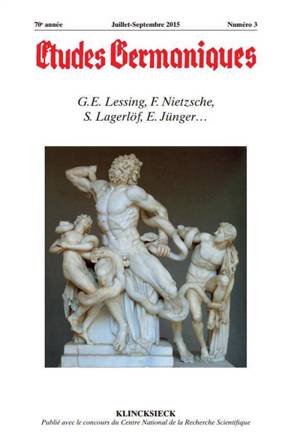
Door een staking bij bpost kan je online bestelling op dit moment iets langer onderweg zijn dan voorzien. Dringend iets nodig? Onze winkels ontvangen jou met open armen!
- Afhalen na 1 uur in een winkel met voorraad
- Gratis thuislevering in België vanaf € 30
- Ruim aanbod met 7 miljoen producten
Door een staking bij bpost kan je online bestelling op dit moment iets langer onderweg zijn dan voorzien. Dringend iets nodig? Onze winkels ontvangen jou met open armen!
- Afhalen na 1 uur in een winkel met voorraad
- Gratis thuislevering in België vanaf € 30
- Ruim aanbod met 7 miljoen producten
Zoeken
Omschrijving
Carolin BOHNLekturen des fruchtbaren Augenblicks Zu Lessings Darstellungstheorie This article analyzes the concept of the "fruitful moment" and provides new insights into Lessing's theory on the conditions of illusion, and awareness. Previous readings have defined the fruitful moment as a temporal element in painting that depends on an already existing narration. Contrarily, the article reveals that the fruitful instant produces aesthetical effects by implicitly representing the limitations of human apperception. From this point of view, Lessing's Laocoon treats poetry no longer as more valuable than painting, but both art forms are considered equal. L'article analyse le concept de l'instant fecond et developpe un nouveau point de vue sur la theorie esthetique de Lessing. Jusqu'a present, le moment fecond chez Lessing etait defini comme un element temporel dans la peinture, dependant de sa place au sein d'une narration. Cette recherche s'attache en revanche a montrer que l'instant fecond produit un effet esthetique en representant implicitement les limites de la perception humaine. Si l'on suit cette perspective, Lessing considere les deux formes d'art comme equivalentes et ne privilegie donc pas la poesie par rapport a la peinture. Boris Roman GIBHARDTSchonheit und Ekel. Zu Lessings "unklassischer" Materialitat der Kunste im Laokoon Lessing's esthetic theory of (com)passion has to be seen with regard to his mate- rial vision of the arts: The effects that visual and poetic arts have to produce since antiquity don't follow from a preconceived norm, but from the artist's sensual con- science of his material. Thus, the marble's beauty suggests coldness and death, words and speech suggest movement and life. In this manner, Lessing contrasts Winckelmann's idea about the Ancient's aspiration to idealism with a theory of "material" imagination.In order to encourage passion, theAncients did represent the abhorrent and ugly, but only until the moment when beauty prevails over other sensual expressions of life and death, because aesthetic pleasure cannot arise from beauty itself. Thus, Lessing challenges classicism and anticipates Romanticism as can be shown by referring to Goethe, Delacroix, Byron and Baudelaire. L'esthetique lessingienne de la (com)passion peut egalement etre lue comme une esthetique de la materialite de l'art: les effets differents que doivent produire l'art visuel et l'art poetique depuis l'Antiquite ne resultent pas d'une norme preconcue, mais d'une conscience sensuelle des effets differents des matieres artistiques comme la relation entre froideur, mort et beaute du marbre par rapport au mouvement et a l'energie de la parole. Ainsi, Lessing oppose a l'idee winckelmanienne, selon laquelleles Anciens auraient voulu realiser l'ideal du beau, une poetique de l'imagination materielle: afin d'encourager la passion, ils ont tout a fait represente ce qui est repoussant, laid, degoutant, pour equilibrer justement le moment delicat ou le beau y prend le dessus sur d'autres expressions sensuelles de la vie et de la mort. Car le plaisir esthetique ne peut se fonder sur l'ideal du beau seul. Ainsi, Lessing se revele precurseur du non-classique et du Romantisme, ce qui sera demontre par rapport a Goethe, Delacroix, Byron, Baudelaire et d'autres. Christoph SCHMALZLEInszeniertes Antikenstudium. Lessings Laokoon und die Laokoon-Gruppe im Vatikan Despite the success which Lessing's Laokoon enjoys, the engagement with ancient art remains an episode in his work. The starting point of his project is not the sculpture that gave it its name, but rather the semiotic distinction between spatial and temporal art forms, two aspects that proved unexpectedly challenging in their combination. Lessing's own complex staging of reading Winckelmann plays a key role in the text's efficacy and impact. The approval which the Laokoon essay received from writers contrasts with the skepticism of artists and art historians: the text does not offer a pure a priori semiotics, but instead functions also as a normative aesthetics which sets fairly narrow limits for art. Already around 1800, artists like Carstens, Flaxman and Canove protested such limitations with their works. En depit du succes rencontre par Laocoon, la confrontation de Lessing avec les oeuvres antiques ne fut qu'un episode dans l'ensemble de sa creation. Le point de depart du projet n'est pas la sculpture antique qui donne son titre au livre mais la distinction semiotique entre arts de l'espace et arts du temps, la relation entre ces deux aspects se revelant plus delicate qu'attendu. Un role cle revient a la mise en scene complexe de la lecture par Lessing de Winckelmann qui confere seule au livre l'effet marquant qu'il produit. A l'opinion favorable dont Laocoon jouit aupres des litterateurs fait face le scepticisme des artistes et historiens de l'art. Le texte ne propose pas de semiotique sous une forme pure, il est en meme temps une esthetique normative qui assigne a l'art d'etroites limites. Des les annees 1800, des artistes tels que Cartens, Flaxman ou Canova, ont proteste a travers leurs oeuvres contre cette conception.
Specificaties
Betrokkenen
- Auteur(s):
- Uitgeverij:
Inhoud
- Aantal bladzijden:
- 200
- Taal:
- Frans
- Reeks:
- Reeksnummer:
- nr. 3
Eigenschappen
- Productcode (EAN):
- 9782252039694
- Verschijningsdatum:
- 23/11/2015
- Uitvoering:
- Paperback
- Formaat:
- Trade paperback (VS)
- Afmetingen:
- 150 mm x 230 mm
- Gewicht:
- 240 g

Alleen bij Standaard Boekhandel
+ 50 punten op je klantenkaart van Standaard Boekhandel
Beoordelingen
We publiceren alleen reviews die voldoen aan de voorwaarden voor reviews. Bekijk onze voorwaarden voor reviews.











